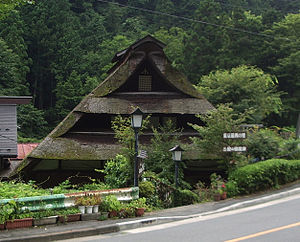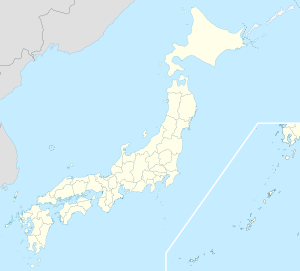Hinohara (Tokyo)
| Hinohara-mura 檜 原 村 |
||
|---|---|---|
| Geographical location in Japan | ||
|
|
||
| Region : | Kanto | |
| Prefecture : | Tokyo | |
| Coordinates : | 35 ° 44 ' N , 139 ° 9' E | |
| Basic data | ||
| Surface: | 105.41 km² | |
| Residents : | 2012 (October 1, 2019) |
|
| Population density : | 19 inhabitants per km² | |
| Community key : | 13307-8 | |
| Symbols | ||
| Flag / coat of arms: | ||
| Tree : | Hinoki cypress | |
| Flower : | Kerrie | |
| Bird : | Japanese Bush Warbler | |
| town hall | ||
| Address : |
Hinohara Village Hall 467 - 1 , Hinohara -mura, Nishitama-gun Tōkyō 190-0212 |
|
| Website URL: | http://www.vill.hinohara.tokyo.jp/ | |
| Location of Hinoharas in Tokyo Prefecture | ||
Hinohara ( Japanese 檜 原 村 , Hinohara-mura ) is a village community ( mura ) in the district of Nishitama ("West Tama") in the Japanese prefecture of Tokyo . It is the last remaining village in the main island part of the prefecture. A large part of the municipality consists of mountain forests, the highest point is the 1,531 m high summit of Mitosan .
geography
The center of Hinohara ( Motoshuku ) lies at the mouth of the Kita-Akigawa ( "North") in the Minami-Akigawa ( "South Akigawa"), which then as Akigawa flows east and the city of Hachioji in the Tamagawa opens . Below are the districts of Kami- and Shimo-Motogō. Most of the remaining settlement lies in the valleys of Kita- and Minami-Akigawa and smaller side valleys. 93% of the community area is forested.
In the west, Mitō-san lies on the border with Okutama and Yamanashi Prefecture (city of Uenohara ), also on the border with Okutama, in the north-west is the 1,405 m high Gozen-yama and in the north the 1,266 m high Ōdake, in the south the Shōtō-san (990 m) on the border with the city of Sagamihara in Kanagawa Prefecture . On the border between the prefectures of Tokyo, Yamanashi and Kanagawa (and the former provinces of Musashi , Sagami and Kai ) there is the “Three Provinces Pass” (Sangoku-tōge, also Sangoku-san) near Shōtō at 960 m Pass in the sense of a significant traffic route. In the southeast, Hinohara shares the Ichimichi-yama (795 m) and the Usuki-yama (842 m) with the neighboring city of Akiruno . Right in Hinohara, between the two river valleys, are the Sengen-rei ( 浅 間 嶺 ; 903 m) and the Matsubae-yama ( 松 生 山 ; 933 m).
A significant part of the municipality in the northwest is part of the Chichibu-Tama-Kai National Park .
history
Hinohara-mura has existed since the introduction of modern city and village communities in 1889 without any significant change in area. Since the transfer of the western Tama area from Kanagawa Prefecture in 1893, it has been part of Tokyo Prefecture.
traffic
The main roads in Hinoharas are prefecture route 33, which leads from Akiruno through the valley of Minami-Akigawa, but then leaves it in the south towards Sagamihara, prefectural route 206, which follows the southern valley further west and then over the mountains to Okutama Lake, and prefecture road 205 through the valley of the Kita-Akigawa.
Public transport are regular buses of the Nishi-Tōkyō Bus , which belongs to the Keiō group .
Attractions

Several hiking and mountain hiking trails lead through Hinohara. There are over 50 waterfalls in the community. In the west on Mitō-san is the almost 200 hectare Hinohara Tomin no Mori ("Forest of the Prefectural Citizens") with several circular routes and a small museum, one of two such prefecture forests in Tokyo. Nearby in the southern valley is a small hot spring, the Kazuma Onsen .
Public facilities
The village runs the Hinohara Elementary and Middle School. There is a day nursery, but no kindergarten, secondary schools or universities in Hinohara.
Hinohara belongs to Police District 9 of the Tokyo Police Department , responsible for the Itsukaichi precinct in Akiruno city. There are three rural police booths ( chūzaisho ) in Hinohara . Since 1974 Hinohara has belonged to the area of responsibility of the Tokyo Fire Department , which until 1960 was only responsible for the former metropolitan area of Tokyo, but is now responsible for almost the entire prefecture. The fire station Akigawa in the city of Akiruno has a field office in Hinohara.
Web links
Individual evidence
- ↑ Environment Ministry: Chichibu Tama Kai National Park (Japanese, parts in English ), map (PDF; 2.9 MB), accessed on June 19, 2020.
- ↑ Tōkyō-to Hinohara Tomin no Mori , Official Website (Japanese)
- ↑ Tokyo Prefecture Environment Agency : Hinohara Tomin no Mori , accessed June 19, 2020.
- ↑ 檜 原 村 Hinohara-mura : 観 光 ・ み ど こ ろ kankō ・ midokoro (Japanese: tourism / sightseeing), accessed June 19, 2020.
- ↑ Tokyo Prefecture Environment Agency: Sightseeing in Hinohara and Akiruno (English), accessed on June 19, 2020.
- ↑ Hinohara: 子 育 て ・ 教育 kosodate ・ kyōiku (Japanese: raising children, education), accessed June 19, 2020.




